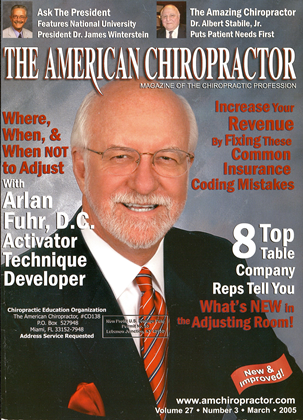WHEN I BEGIN THE CONSULTING PROCESS WITH DOCTORS, I start off by asking them two important questions. "What do you feel is your practice's number one need? What amount of services would you like to collect each month?" The response to question one is almost always, "New patients." Mistakenly, many doctors believe this is also the answer to more collections. The relief I see on their faces is palpable when I point out that, in the majority of these offices, they are already seeing the right number of patients to achieve higher collection goals. They can do this by understanding correct procedural coding and case management documentation. Understanding Your Earning Potential It is so important that doctors understand their full earning potential. Most chiropractic offices have no idea why they bill what they bill, nor do they realize they could and should be billing other procedures. I am not recommending that offices bill seven procedure codes per visit! Good case management and increased reimbursement is nothing more than understanding the case, and documenting and billing appropriately for services rendered. It truly is as easy as it sounds, if you understand the process. As humans, we are afraid of the unknown and we run from it. Insurance is just like any other unknown. If you take the time to learn and understand, you will see it is merely just another system that you and your staff can master. Here are some examples. Do you know why you bill 99203 for your new patient code? Did you realize there are actually three different types of new patient codes to choose from? Most offices never use the consultation code (9924x) or the confirmatory consultation (9927X) code. If you have a patient that has seen another doctor for the same condition, but came to you of his or her own accord, then you should bill 9927X. Not only are you missing out on the increased revenue, but you are not telling (documenting) the appropriate story. The majority of doctors I work with do not even know these codes exist. I believe this is a common problem in chiropractic practices. You will notice I have put an "X" in the fifth digit because you need to determine what level it is. When I ask doctors why they bill a level three, the majority of them do not know. They may have inherited a fee schedule somewhere along the way. The number one problem I see in the chiropractic profession is the improper use of evaluation and management (E/M) codes. If you read the first seven pages of the Current Procedural Terminology (CPT) book, you will see how to determine the proper level for the E/M code. These levels will set the tone of the case in the insurance company's mind. The insurance companies have what are called value drivers, and they all come from the codes you bill and the documentation you provide. If we can understand this process and educate the profession on those drivers, then we will begin to see a light at the end of the tunnel. This is the power of knowledge and this is why I do what I do. I tell my clients to forget about the fi- nancial side of billing and look at it as if you were writing a story and your Health Care Financing Administration (HCFA) is a page in this storybook. You need to make sure you are telling the best possible story you can. Don't write a fictional story; write the truth. If the patient has seen another physician for this condition, it shows the complexity of the case, and you need to inform the insurance company. You need to set the stage in the very beginning, so they know what to expect from this case in the future. Understanding your coding will not only get you more money per case, it will help in the never ending search for the proof of medical necessity. Medical necessity is becoming the number one reason for denial of care. It is hard to prove medical necessity when all you have is an opinion to back you up. I believe in a low overhead practice and feel that chiropractors spend way too much money on machinery/gadgets. I do, however, recommend the use of computerized range of motion and muscle testing. The use of this technology removes the subjective opinion in your practice and allows you to provide valid objective data on the condition of your patients. You should use this on every patient you have, no matter what the type. You need to establish a baseline on your patients and, then, continue to measure them throughout care. I recommend you do it consistently every 12 visits. Range of motion and muscle strength testing is the only way I know that every clinician, regardless of their technique, can demonstrate medical necessity effectively. You can bill for this and expect to get paid 60% of the time. In my opinion, the key to today's successful practice is case management. A doctor needs to understand correct procedural coding and case management documentation. It all comes down to reflecting the appropriate story to the insurance companies through your patient reports and HCFA billing forms. The day of getting people well, and that's being enough, are gone. It is not a difficult game; you just need to understand the rules. Hharon Hoag. a Certified Professional Coder through the American Medical Association (AMA). founder and president of Hybrid Management. Inc. has .spent the last 5 years traveling across the United States teaching chiropractors proper coding and case management strategies. Visiting over 3500 chiropractic offices gives him a strong grasp of the challenges facing the modern day chiropractic clinic. For more information, call 740-398-3611 or visit www.hybridmanagement.net.
 View Full Issue
View Full Issue






